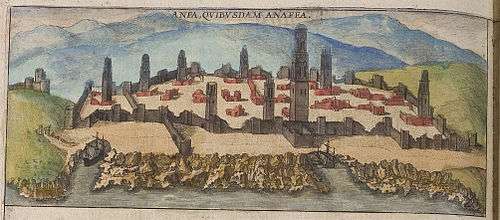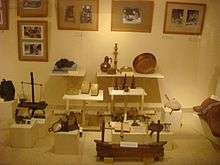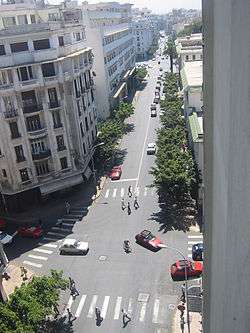History of Casablanca

The history of the city of Casablanca in Morocco has been one of many political and cultural changes. At different times it has been governed by Berber, Roman, Arab, Portuguese, Spanish, French, British, and Moroccan regimes. It has had an important position in the region as a port city, making it valuable to a series of conquerors during its early history.
The original Berber name, Anfa (meaning: "hill" in English[1]), was used by the locals, and Berber-speaking, city dwellers until the French occupation army entered the city in 1907 and adopted the Spanish name, Casablanca. "Anfa" now refers to the original old city quarters of Casablanca.
Roman Anfa
Anfa est une grande cité, edifiée par les Romans sur le rivage de la mer Oceane... (Leo Africanus: Anfa is a big city, built by the Romans on the ocean shore...)
The area which is today Casablanca was founded and settled by the Berbers by about the 10th century BC.[2] It was used as a port by the Phoenicians and later by the Romans.[3]
Romans occupied the area in 15 BC and created a commercial port,[4] directly connected to the Mogador island in the Iles Purpuraires of southern Mauritania. From there they obtained a special dye, that colored the purple stripe in Imperial Roman Senatorial togas. The expedition of Juba II to discover the Canary islands and Madeira probably departed from Anfa.
The Roman port, probably called Anfus, was part of a Berber client state of Rome until Emperor Augustus. When Rome annexed Ptolemy of Mauretania's kingdom, Anfa was incorporated into the Roman Empire by Caligula. But this was done only nominally because the Roman limes was a few dozen kilometers north of the port (the Roman military fortifications of Mauretania Tingitana were just a few kilometers south of the Roman colonia named Sala Colonia). However, Roman Anfa—connected mainly by commerce and by socio-cultural ties to Volubilis ("autonomous" from Rome since 285 AD)—lasted until the 5th century, when Vandals conquered Roman northwestern Africa.
A Roman wreck of the 2nd century, from which were salvaged 169 silver coins, shows that the Romans appreciated this useful port for commerce. There is even evidence of oil commerce with Roman Volubilis and Tingis in the 3rd century.
Meanwhile, a large Berber tribe, the Berghouata, settled in the area between the rivers Bou Regreg to the north and Oum er-Rbia to the south of the Roman port.[5] Consequently, the independent Berber kingdom called Barghawata, in the area then named Anfa, arose around in 744 AD, and continued until it was conquered by the new Berber kingdom of the Almoravids in 1068 AD.
Abou El Kassem El Ziani refers to ancient Casablanca as "Anfa" and stated that the Zenatiyins (Berber dynasty under Arab rule) were the first people that established Anfa in the period of their settlement in Tamassna.[6]
Leo Africanus defined Anfa as a Roman city in his famous Della descrittione dell’Africa et delle cose notabili che ivi sono (Description of Africa), written in the 16th century.
Before the French Protectorate
During 14th century, under the Berber dynasty Merinids, the town rose in importance as a port and in the early 15th century, became independent once again. It emerged as a safe harbour for pirates. This led to attacks by the Portuguese, who destroyed the town in 1468 AD. The Portuguese used the ruins to build a military fortress in 1515 AD. The village that grew up around it was called "Casabranca", meaning "White House" in Portuguese. They eventually abandoned the area completely in 1755 AD following an earthquake which destroyed it.

The town and the medina of Casablanca as it is today was founded in 1770 AD by sultan Mohammed ben Abdallah (1756–1790), the grandson of Moulay Ismail. Built with the aid of Spaniards, the town was called Casa Blanca (white house in Spanish) translated Dar el Beida in Arabic.
Casablanca's street plan is based on that of a French architect named Henri Prost, who placed the center of the city where the main market of Anfa had been. From this point all main streets radiate to the east and to the south. More city plans were developed in 1946 AD, and later in the 1980s.
In the 19th century Casablanca became a major supplier of wool to the booming textile industry in Britain and shipping traffic increased (the British, in return, began importing Morocco's now famous national drink, gunpowder tea). By the 1860s, there were around 5,000 residents, and the population grew to around 10,000 by the late 1880s.[7] Casablanca remained a modestly sized port, with a population reaching around 12,000 within a few years of the French conquest and arrival of French colonialists in the town, at first administrators within a sovereign sultanate, in 1906. By 1921, this was to rise to 110,000,[7] largely through the development of bidonvilles
French rule

In June 1907, the French attempted to build a light railway near the port and passing through a graveyard. Residents attacked the French workers, and riots ensued. French troops were landed in order to restore order, which was achieved only after severe damage to the town. The French then took control of Casablanca. This effectively began the process of colonialisation, although French control of Casablanca was not formalised until 1910. It was especially during the years of military governor Hubert Lyautey that Casablanca became Morocco's economic center and Africa's biggest harbour.
The famous 1942 film Casablanca underlined the city's colonial status at the time—depicting it as the scene of a power struggle between competing European powers, carried out without any reference to the local population, and with the film's vast cosmoplitan cast of characters (American, French, German, Czech and some other nationalities) including not a single Arab.
During the 1940s and 1950s, Casablanca was a major centre of anti-French rioting. A terrorist bomb on Christmas Day of 1953 killed 16 people.[8]
The Casablanca Conference
Casablanca was an important strategic port during World War II and hosted the Casablanca Conference -called even "Anfa Conference"- in 1943 (from January 14 to January 24), in which Churchill and Roosevelt discussed the progress of the war. Casablanca was the site of a large American air base, which was the staging area for all American aircraft for the European Theater of Operations during World War II.
Since independence
Morocco regained independence from France on 2 March 1956.
In 1930, Casablanca hosted a round of the Formula One world championship. The race was held at the new Anfa Racecourse. In 1958, the race was held at Ain-Diab circuit - (see Moroccan Grand Prix). In 1983, Casablanca hosted the Mediterranean Games.
The city is now developing a tourism industry. Casablanca has become the economic and business capital of Morocco, while Rabat is the political capital.
In March 2000, women's groups organised demonstrations in Casablanca proposing reforms to the legal status of women in the country. 40,000 women attended, calling for a ban on polygamy and the introduction of divorce law (divorce being a purely religious procedure at that time). Although counter-demonstration attracted half a million participants, the movement for change started in 2000 was influential on King Mohammed VI, and he enacted a new Mudawana, or family law, in early 2004, meeting some of the demands of women's rights activists.
On May 16, 2003, 33 civilians were killed and more than 100 people were injured when Casablanca was hit by a multiple suicide bomb attack carried out by Moroccans and claimed by some to have been linked to al-Qaeda.
A string of suicide bombings struck the city in early 2007. A suspected militant blew himself up at a Casablanca internet cafe on March 11, 2007. On April 10, three suicide bombers blew themselves up during a police raid of their safe house.[9] Two days later, police set up barricades around the city and detained two more men who had escaped the raid.[10] On April 14, two brothers blew themselves up in downtown Casablanca, one near the American Consulate, and one a few blocks away near the American Language Center. Only one person was injured aside from the bombers, but the Consulate was closed for more than a month.[11]
See also
References
- ↑ Miller, Catherine (2007). Arabic in the City: Issues in Dialect Contact and Language Variation. Routledge. p. 100. ISBN 978-0-415-77311-9. Retrieved 22 April 2012.
- ↑ Casablanca - Jewish Virtual Library
- ↑ LexicOrient
- ↑ Roman Casablanca
- ↑ Roman Anfa
- ↑ Berber Casablanca
- 1 2 Pennel, CR: Morocco from Empire to Independence, Oneworld, Oxford, 2003, p 121
- ↑ "16 Dead in Casablanca Blast". New York Times. 25 December 1953. Retrieved 4 October 2010. (subscription required (help)).
- ↑ Terror Cell: 'Police Hold Fifth Man' April 12, 2007
- ↑ Casablanca on alert after suicide bombings April 12, 2007
- ↑ U.S. Shuts Morocco Consulate After Bomb April 15, 2007
Further reading
- Published in the 20th century
- "Casablanca", The Encyclopaedia Britannica (11th ed.), New York: Encyclopaedia Britannica, 1910, OCLC 14782424
- Published in the 21st century
- Michael R.T. Dumper; Bruce E. Stanley, eds. (2008), "Casablanca", Cities of the Middle East and North Africa, Santa Barbara, USA: ABC-CLIO
External links
Maghreb Arabe Presse: 500k-year human fossil remains found in Casablanca (05/26/2006)
%2C_Algeria_04966r.jpg)